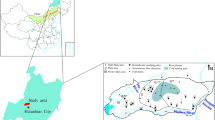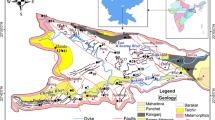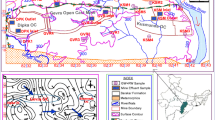Abstract
Sungun mine is the largest open-cast copper mine in northwest of Iran and is in the primary stages of extraction. The influence of mining activity on the quality of regional groundwater has been taken in to consideration in this study. Accordingly, sampling was done from 22 springs in the study area. The concentrations of major anions and cations as well as Al, Cu, Cd, Cr, Fe, Mn, and Zn were determined for all 22 spring samples in mid-August 2005. The results showed that the concentrations of most of these elements were below the USA Environmental Protection Agency (EPA) limits; however, Al and Fe concentrations are considered to be more than limits in a couple of samples. Despite the fact that geological formations are highly weathered and fractured, the dissolution of minerals within the study area is low. This may be justified by the relatively high alkalinity of local underground water which keeps metals in solid phase and does not let them enter dissolved phase. Additionally, this may be attributed to the high velocity of groundwater flows, which do not give enough time for minerals to dissolve. Correlation coefficients among water chemistry components were determined and the weighted-pair group method was chosen for cluster analysis. Accordingly, high correlation among Al, Fe and Cr, Cd ,and Cu, sodium absorption ratio (SAR) and Na as well as total hardness (TH), Ca, and Mg were observed. The chemical characteristics of water compositions on the basis of major ion concentrations were evaluated on a Schoeller and Piper diagram. Accordingly, the dominant type of water in the region is considered to be Ca-HCO3 (calcium-bicarbonate type). However, this type of water is also rich in Na, K, and especially Mg. Regarding Schoeller diagram, the current status of local underground water is good for drinking purposes. By commencing mining excavation with designed capacity in near future, the minerals will come into contact with air and water resulting in dissolution, especially in ponds, which, in turn, will increase the concentration of toxic metals in groundwater. Considering future uses of this water including for drinking, irrigation, industrial purposes, etc., precautions must be taken in to consideration.







Similar content being viewed by others
References
Baba A, Gungor T (2002) Influence of gold mine on groundwater quality (Efemcukuru, Izmir, Turkey). Environ Geol 41:621–627
Banwart SA, Malmstrom ME (2001) Hydrochemical modelling for preliminary assessment of minewater pollution. J Geochem Explor 74:73–97
Bell FG, Stacey TR, Genske DD (2000) Mining subsidence and its effect on the environment: some differing examples. Environ Geol 40(1–2):135–152
Davis JC (1973) Statistics and data analysis in geology. Wiley, New York, pp 456–473
Eggert RG (1994) Mining and the environment: an introduction and overview. In: Eggert RG (ed) Mining and the environment: international perspectives on public policy. Resources for the future (REF), Washington, pp 1–20
Gabler HE, Schneider J (2000) Assessment of heavy-metal contamination of floodplain soils due to mining and mineral processing in the Harz mountains, Germany. Environ Geol 39(7):774–782
Karbassi AR, Nouri J, Ayaz GO (2007) Flocculation of trace metals during mixing of Talar river water with Caspian Seawater. Int J Environ Res 1(1):66–73
Lottermoser BG, Ashley PM, Lawie DC (1999) Environmental geochemistry of the Gulf Creek copper mine area, north-eastern New South Wales, Australia. Environ Geol 39(1):61–74
Malinovsky D, Rodushkin I, Moiseenko T, Ohlander B (2002) Aqueous transport and fate of pollutants in mining area: a case study of Khobiny apatite-nepheline mines, the Kola Peninsula, Russia. Environ Geol 43(1–2):172–187
Marszalek H, Wasik M (2000) Influence of arsenic-bearing gold deposits on water quality in Zloty Stok mining area (SW Poland). Environ Geol 39(8):888–892
Modabberi S, Moore F (2004) Environmental Geochemistry of Zarshuran Au–As deposit, NW Iran. Environ Geol 46(6–7):796–807
Munroe EA, McLemore VT, Kyle P (1999) Waste rock pile characterization, heterogeneity, and geochemical anomalies in the Hillsboro Mining District, Sierra County, New Mexico. J Geochem Explor 67:391–405
Nabi Bidhendi GR, Karbassi AR, Nasrabadi T, Hoveidi H (2007) Influence of copper mine on surface water quality. Int J Sci Technol 4(1):85–91
Ripley EA, Redmann RE, Crowder AA (1996) Environmental effects of mining. St. Lucie Press, Delray Beach
Santos A, Alonso E, Callejon M, Jimenez JC (2002) Distribution of Zn, Cd, Pb and Cu metals in groundwater of the Guadiamar river basin, Water. Air Soil Pollut 134(1–4):273–283
Stamatis G, Voudouris K, Karefilakis F (2001) Groundwater pollution by heavy metals in historical mining area of Lavrio, Attica, Greece, Water. Air Soil Pollut 128(1–2):61–83
Standard methods for the examination of water and wastewater (1998) American Public Health Association, Washington, pp 2005–2605
Woo NC, Choi MJ (2001) Arsenic and metal contamination of water resources from mining wastes in Korea. Environ Geol 40(3):305–311
Yung HB, Yum ST, Mayer B, Kim SO, Park SS, Lee PK (2005) Transport and sediment-water partitioning of trace metals in acid mine drainage: an example from the abandoned Kwangyang Au-Ag mine area, South Korea. Environ Geol 48(4–5):437–449
Author information
Authors and Affiliations
Corresponding author
Rights and permissions
About this article
Cite this article
Nasrabadi, T., Nabi Bidhendi, G.R., Karbassi, A.R. et al. Influence of Sungun copper mine on groundwater quality, NW Iran. Environ Geol 58, 693–700 (2009). https://doi.org/10.1007/s00254-008-1543-2
Received:
Accepted:
Published:
Issue Date:
DOI: https://doi.org/10.1007/s00254-008-1543-2




